The Smart Contact Lens Market is estimated to be valued at USD 404.5 million in 2025 and is projected to reach USD 1128.0 million by 2035, registering a compound annual growth rate (CAGR) of 10.8% over the forecast period.
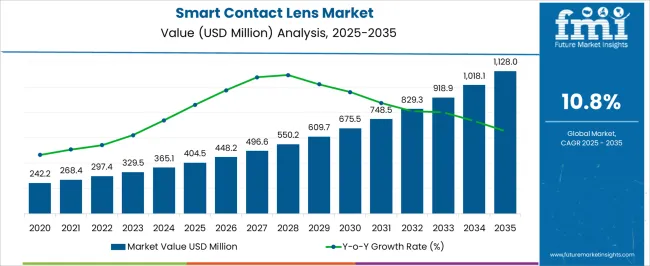
| Metric | Value |
|---|---|
| Smart Contact Lens Market Estimated Value in (2025 E) | USD 404.5 million |
| Smart Contact Lens Market Forecast Value in (2035 F) | USD 1128.0 million |
| Forecast CAGR (2025 to 2035) | 10.8% |
The smart contact lens market is witnessing steady expansion, driven by the convergence of healthcare technologies, miniaturized electronics, and growing patient demand for advanced wearable solutions. These lenses are being increasingly adopted for applications that go beyond vision correction, particularly in areas such as health monitoring, drug delivery, and augmented reality. Advancements in micro-sensors, wireless connectivity, and biocompatible materials are improving the performance and safety profile of smart lenses, making them more suitable for long-term use.
The rising prevalence of chronic conditions, particularly diabetes, is driving demand for innovative solutions that can provide continuous monitoring without disrupting daily routines. Growing collaborations between healthcare providers, technology developers, and manufacturers are accelerating product development and regulatory approvals.
Increasing investments in smart healthcare infrastructure and patient-centric devices are also contributing to the market’s momentum As consumers and healthcare systems prioritize convenience, real-time data, and non-invasive monitoring methods, the smart contact lens market is expected to experience strong growth, supported by innovation and expanding commercial adoption across global markets.
The smart contact lens market is segmented by type, application, end user, and geographic regions. By type, smart contact lens market is divided into Daily-Wear Soft Lenses, Rigid Gas-Permeable (RGP), Extended-Wear Lenses, and Others. In terms of application, smart contact lens market is classified into Continuous glucose monitoring, Continuous intraocular pressure monitoring, and Others. Based on end user, smart contact lens market is segmented into Hospitals, Ophthalmology Clinics, and Others. Regionally, the smart contact lens industry is classified into North America, Latin America, Western Europe, Eastern Europe, Balkan & Baltic Countries, Russia & Belarus, Central Asia, East Asia, South Asia & Pacific, and the Middle East & Africa.
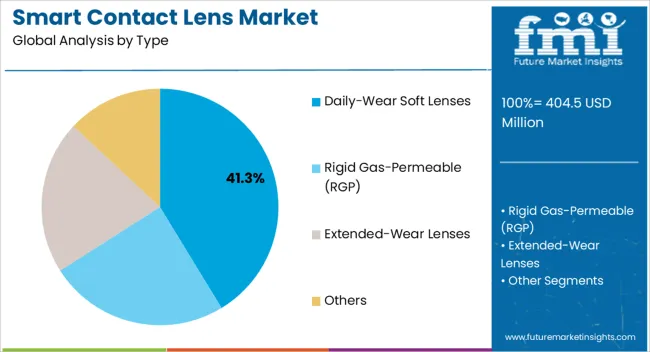
The daily-wear soft lenses segment is projected to hold 41.3% of the smart contact lens market revenue share in 2025, making it the leading type segment. Its dominance is being reinforced by the comfort, convenience, and adaptability offered to users, who prefer lenses that can be worn throughout the day and easily replaced. The segment’s growth is supported by the integration of sensors and electronic components into flexible lens materials without compromising comfort or oxygen permeability, a critical factor in ensuring ocular health.
The preference for disposable and daily-use formats also minimizes risks of infection, which enhances patient confidence and adoption. Manufacturers are increasingly focusing on designing soft lenses with embedded health-monitoring capabilities, including glucose sensing and intraocular pressure detection, which expands their utility beyond vision correction.
Growing acceptance of contact lenses as lifestyle products, combined with the added functionality of smart features, is further driving market leadership As advancements in materials science and microelectronics continue, daily-wear soft lenses are expected to maintain their position as the most widely adopted smart lens type globally.
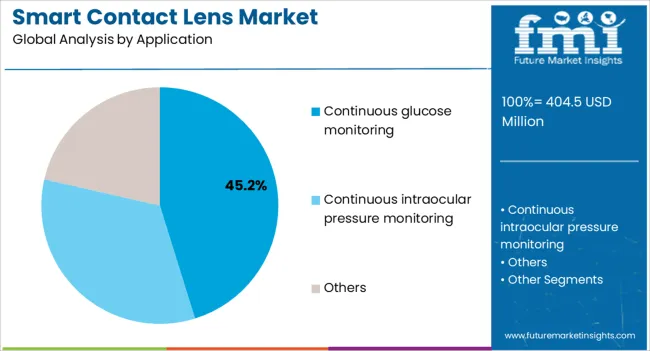
The continuous glucose monitoring segment is anticipated to represent 45.2% of the smart contact lens market revenue share in 2025, making it the leading application area. Its dominance is being driven by the rising global prevalence of diabetes and the increasing need for non-invasive, real-time glucose monitoring solutions. Smart contact lenses designed for this application are capable of analyzing tear fluid glucose levels, reducing reliance on traditional blood-based testing methods and improving patient compliance.
The ability to transmit real-time data to connected devices enhances disease management and enables timely interventions, improving overall health outcomes. The segment’s leadership is further supported by the growing emphasis on preventive healthcare and patient empowerment, as individuals seek seamless monitoring solutions integrated into their daily lives.
Regulatory support for innovative diabetes management tools and rising investments by healthcare technology companies are accelerating development in this space As the burden of diabetes continues to grow, continuous glucose monitoring through smart lenses is expected to remain the most impactful and widely adopted application in the market.
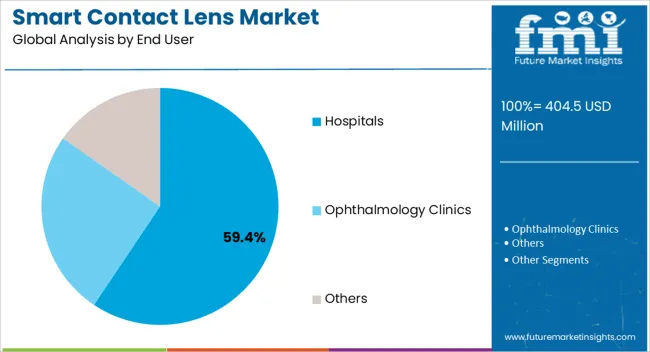
The hospitals segment is expected to capture 59.4% of the smart contact lens market revenue share in 2025, establishing itself as the leading end-user category. Its dominance is being driven by the critical role hospitals play in the diagnosis, monitoring, and management of chronic and acute health conditions, making them primary adopters of advanced medical technologies. Hospitals are increasingly integrating smart contact lenses into patient care programs to provide continuous monitoring and support early detection of complications.
The ability of these devices to deliver real-time health data enhances clinical decision-making, reduces the need for invasive testing, and improves patient compliance. Strong investment in hospital infrastructure and digital health systems is also accelerating adoption, as institutions prioritize connected medical devices that integrate with electronic health records.
The segment’s leadership is further supported by ongoing collaborations between hospitals, technology developers, and healthcare providers to validate and scale clinical use cases As patient-centric care models gain prominence, hospitals are expected to remain the largest end-user segment, reinforcing the market’s growth trajectory.
Consumer electronics integration plays a crucial role in the growth of smart contact lenses. Enhanced connectivity allows these lenses to interface with smartphones, wearables, and other IoT devices, expanding their functionality from health monitoring to real-time information display. Improved user experience in terms of comfort, ease of use, and extended wear time also makes these lenses more appealing to consumers, encouraging broader adoption.
Rising health awareness among consumers also plays a significant role. There is a growing trend towards preventive healthcare, with individuals seeking regular monitoring of vital signs to catch potential health issues early. Smart contact lenses facilitate this by providing continuous health data, which consumers can collect and analyze for better personal health management.
Personalized vision correction is a growing trend in the market. Lenses with adjustable focus or custom vision correction capabilities are being developed to cater to individual visual needs, such as presbyopia and myopia. These lenses can adjust dynamically to different visual requirements, providing a more tailored and effective solution.
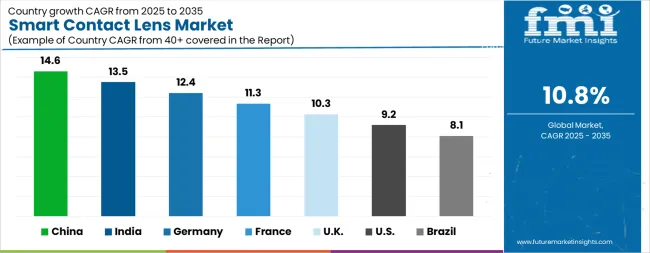
| Country | CAGR |
|---|---|
| China | 14.6% |
| India | 13.5% |
| Germany | 12.4% |
| France | 11.3% |
| UK | 10.3% |
| USA | 9.2% |
| Brazil | 8.1% |
The Smart Contact Lens Market is expected to register a CAGR of 10.8% during the forecast period, exhibiting varied country level momentum. China leads with the highest CAGR of 14.6%, followed by India at 13.5%. Developed markets such as Germany, France, and the UK continue to expand steadily, while the USA is likely to grow at consistent rates. Brazil posts the lowest CAGR at 8.1%, yet still underscores a broadly positive trajectory for the global Smart Contact Lens Market. In 2024, Germany held a dominant revenue in the Western Europe market and is expected to grow with a CAGR of 12.4%. The USA Smart Contact Lens Market is estimated to be valued at USD 150.3 million in 2025 and is anticipated to reach a valuation of USD 361.7 million by 2035. Sales are projected to rise at a CAGR of 9.2% over the forecast period between 2025 and 2035. While Japan and South Korea markets are estimated to be valued at USD 21.1 million and USD 13.2 million respectively in 2025.
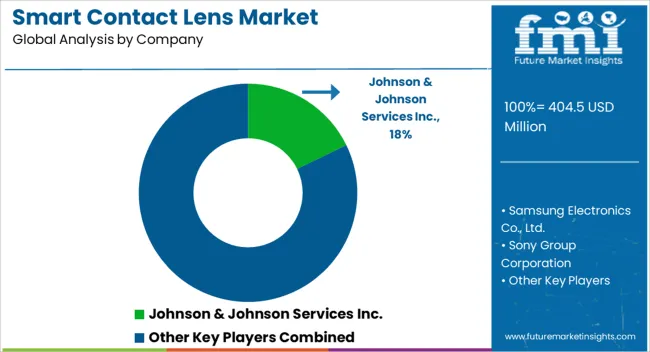
| Item | Value |
|---|---|
| Quantitative Units | USD 404.5 Million |
| Type | Daily-Wear Soft Lenses, Rigid Gas-Permeable (RGP), Extended-Wear Lenses, and Others |
| Application | Continuous glucose monitoring, Continuous intraocular pressure monitoring, and Others |
| End User | Hospitals, Ophthalmology Clinics, and Others |
| Regions Covered | North America, Europe, Asia-Pacific, Latin America, Middle East & Africa |
| Country Covered | United States, Canada, Germany, France, United Kingdom, China, Japan, India, Brazil, South Africa |
| Key Companies Profiled | Johnson & Johnson Services Inc., Samsung Electronics Co., Ltd., Sony Group Corporation, Sensimed, Innovega Inc., InWith Corporation, RaayonNova LLC, Azalea Vision, EP Global Communications, Inc., and GlakoLens Biyomedikal Biyoteknoloji San. ve Tic. A.S. |
The global smart contact lens market is estimated to be valued at USD 404.5 million in 2025.
The market size for the smart contact lens market is projected to reach USD 1,128.0 million by 2035.
The smart contact lens market is expected to grow at a 10.8% CAGR between 2025 and 2035.
The key product types in smart contact lens market are daily-wear soft lenses, rigid gas-permeable (rgp), extended-wear lenses and others.
In terms of application, continuous glucose monitoring segment to command 45.2% share in the smart contact lens market in 2025.






Our Research Products

The "Full Research Suite" delivers actionable market intel, deep dives on markets or technologies, so clients act faster, cut risk, and unlock growth.

The Leaderboard benchmarks and ranks top vendors, classifying them as Established Leaders, Leading Challengers, or Disruptors & Challengers.

Locates where complements amplify value and substitutes erode it, forecasting net impact by horizon

We deliver granular, decision-grade intel: market sizing, 5-year forecasts, pricing, adoption, usage, revenue, and operational KPIs—plus competitor tracking, regulation, and value chains—across 60 countries broadly.

Spot the shifts before they hit your P&L. We track inflection points, adoption curves, pricing moves, and ecosystem plays to show where demand is heading, why it is changing, and what to do next across high-growth markets and disruptive tech

Real-time reads of user behavior. We track shifting priorities, perceptions of today’s and next-gen services, and provider experience, then pace how fast tech moves from trial to adoption, blending buyer, consumer, and channel inputs with social signals (#WhySwitch, #UX).

Partner with our analyst team to build a custom report designed around your business priorities. From analysing market trends to assessing competitors or crafting bespoke datasets, we tailor insights to your needs.
Supplier Intelligence
Discovery & Profiling
Capacity & Footprint
Performance & Risk
Compliance & Governance
Commercial Readiness
Who Supplies Whom
Scorecards & Shortlists
Playbooks & Docs
Category Intelligence
Definition & Scope
Demand & Use Cases
Cost Drivers
Market Structure
Supply Chain Map
Trade & Policy
Operating Norms
Deliverables
Buyer Intelligence
Account Basics
Spend & Scope
Procurement Model
Vendor Requirements
Terms & Policies
Entry Strategy
Pain Points & Triggers
Outputs
Pricing Analysis
Benchmarks
Trends
Should-Cost
Indexation
Landed Cost
Commercial Terms
Deliverables
Brand Analysis
Positioning & Value Prop
Share & Presence
Customer Evidence
Go-to-Market
Digital & Reputation
Compliance & Trust
KPIs & Gaps
Outputs
Full Research Suite comprises of:
Market outlook & trends analysis
Interviews & case studies
Strategic recommendations
Vendor profiles & capabilities analysis
5-year forecasts
8 regions and 60+ country-level data splits
Market segment data splits
12 months of continuous data updates
DELIVERED AS:
PDF EXCEL ONLINE
Contact-lens Induced Infections Market Size and Share Forecast Outlook 2025 to 2035
Contact Lens Inspection Equipment Market Size and Share Forecast Outlook 2025 to 2035
Contact Lens Industry Analysis in GCC Size and Share Forecast Outlook 2025 to 2035
Contact Lenses Market – Trends, Growth & Forecast 2025 to 2035
Contact Lens Solution Market Analysis by Product Type, Volume, Purpose, Distribution Channel, and Region through 2035
Contactless Smart Card Market
Hydrogel Contact Lenses Market
Disposable Contact Lenses Market Trends & Insights 2025-2035
Single Use Contact Lenses Market
Therapeutic Contact Lenses Market Report - Trends, Demand & Outlook 2025 to 2035
Contactless Respiratory Measurement Market Analysis - Size, Share, and Forecast Outlook 2025 to 2035
Smart Meeting Pod Market Size and Share Forecast Outlook 2025 to 2035
Smart Electrogastrogram Recorder Market Size and Share Forecast Outlook 2025 to 2035
Smart Aerial Work Robots Market Size and Share Forecast Outlook 2025 to 2035
Smart Bladder Scanner Market Size and Share Forecast Outlook 2025 to 2035
Smart School Bus Platform Market Size and Share Forecast Outlook 2025 to 2035
Smart Home Wireless Smoke Detector Market Size and Share Forecast Outlook 2025 to 2035
Smart Bus Platform Market Size and Share Forecast Outlook 2025 to 2035
Smart Vision Processing Chips Market Size and Share Forecast Outlook 2025 to 2035
Smart Touch Screen Scale Market Size and Share Forecast Outlook 2025 to 2035

Thank you!
You will receive an email from our Business Development Manager. Please be sure to check your SPAM/JUNK folder too.
Chat With
MaRIA